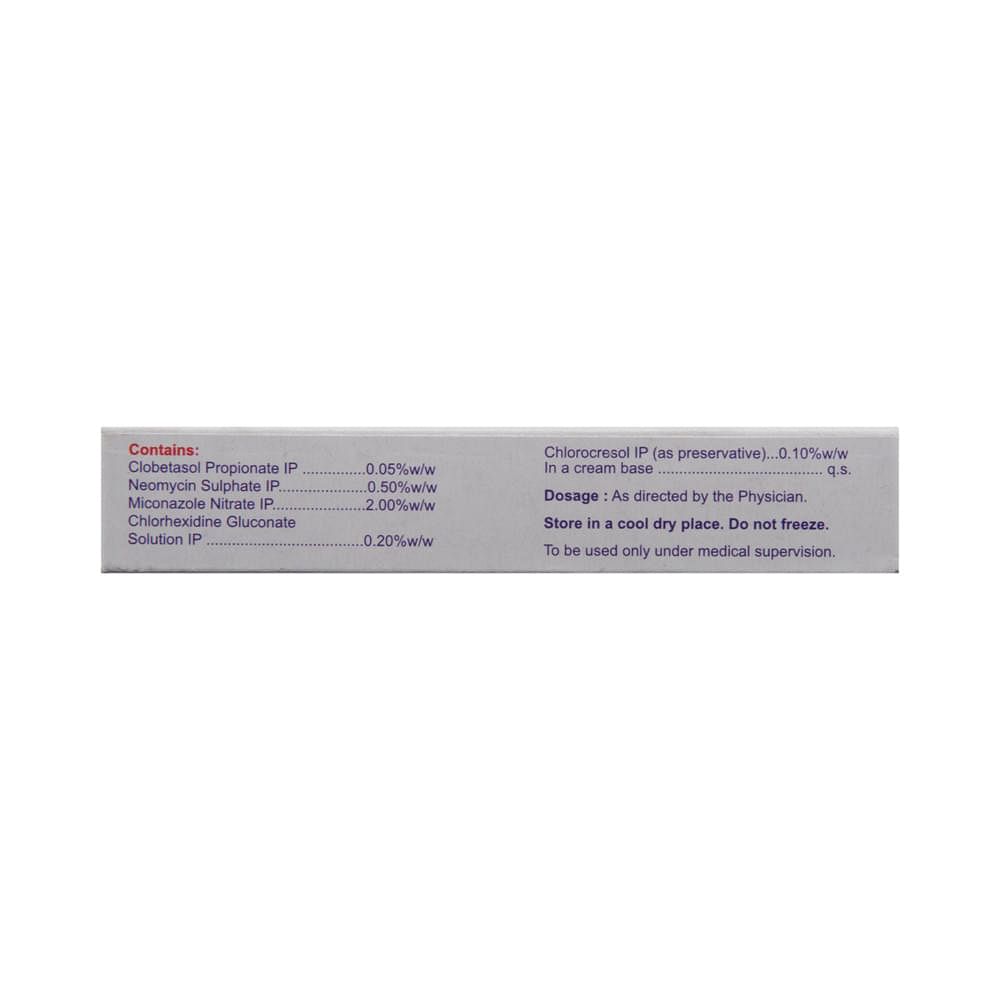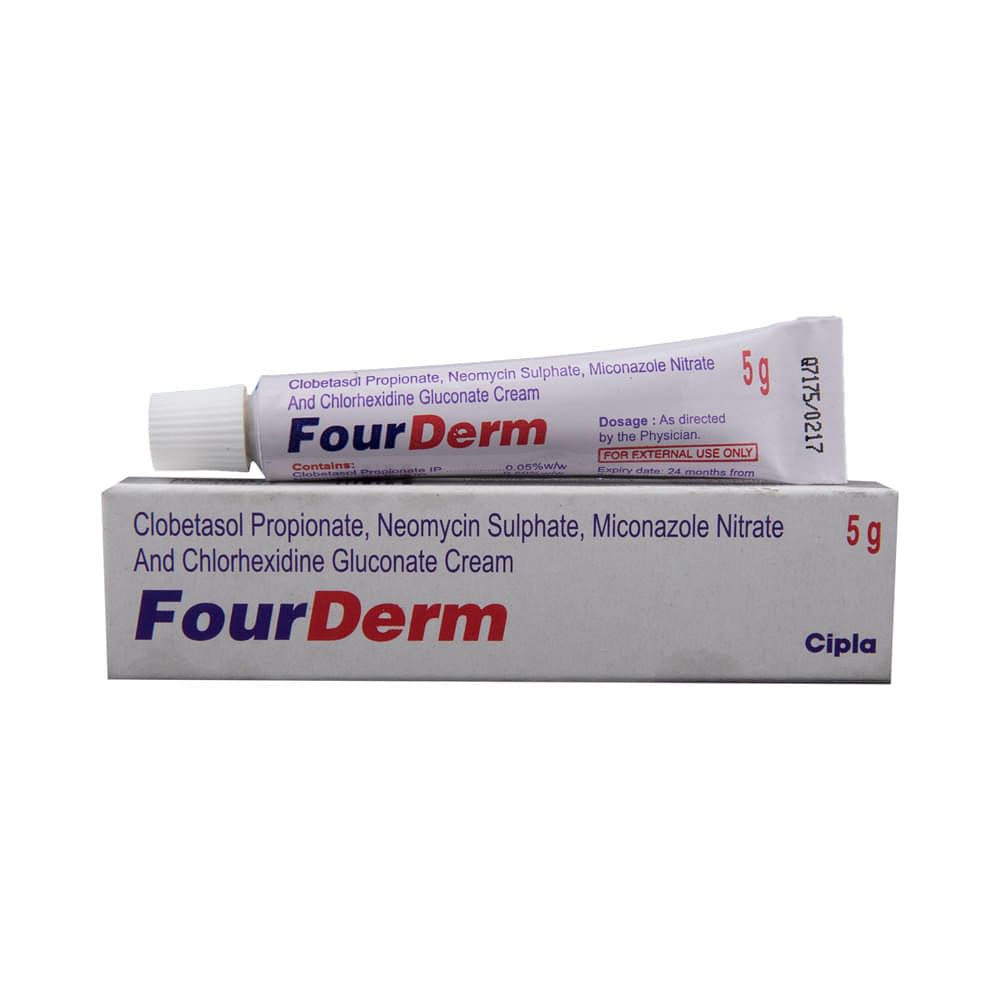



Fourderm Cream
Manufacturer
Cipla Ltd
Salt Composition
Clobetasol (0.05%w/w) + Miconazole (2%w/w) + Neomycin (0.5%w/w) + Chlorhexidine (0.2%w/w)
Key Information
Short Description
Fourderm Cream is a combination of four medicines that effectively treat skin infections.
Dosage Form
Cream
Introduction
Fourderm Cream is advised for external use only. Use it in the dose and duration advised by your doctor. Apply it only on the affected areas of the skin. In case your eyes or mouth get exposed to this medicine accidentally, wash them thoroughly with water. Complete the full course of treatment for better efficacy. This medicine is generally safe, but it may sometimes cause itching, burning sensation, and discomfort. These effects are mild and temporary but if they persist, consult the doctor immediately.
Directions for Use
This medicine is for external use only. Use it in the dose and duration as advised by your doctor. Check the label for directions before use. Clean and dry the affected area and apply the cream. Wash your hands after applying unless hands are the affected area.
Safety Information
Side Effects
Itching burning sensation discomfort
Alcohol Warning
No interaction found/established
Breastfeeding Warning
Fourderm Cream is probably safe to use during breastfeeding. Limited human data suggests that the drug does not represent any significant risk to the baby.
Pregnancy Warning
Fourderm Cream may be unsafe to use during pregnancy. Although there are limited studies in humans, animal studies have shown harmful effects on the developing baby. Your doctor will weigh the benefits and any potential risks before prescribing it to you. Please consult your doctor.
How it works
Fourderm Cream is a combination of four medicines: Chlorhexidine Gluconate, Clobetasol, Miconazole, and Neomycin. Chlorhexidine Gluconate is an antiseptic which effectively cleans out the affected area of skin to prevent infection. Clobetasol is a steroid which works by blocking the production of certain chemical messengers (prostaglandins) that make the skin red, swollen, and itchy. Miconazole is an antifungal which stops the growth of fungi while Neomycin is an antibiotic which kills bacteria that cause skin infections. Together, they treat your skin infection effectively.
Quick Tips
You have been prescribed Fourderm Cream for the treatment of skin infections. Wash your skin with a mild cleanser and pat it dry before applying. Apply it as a thin layer onto a clean, dry, unbroken infected area of skin. Do not share your towel or clothes with anyone and wear clean clothes every day to prevent infection. It may take several weeks to show its action. Keep using it as suggested by your doctor.
Frequently asked questions
How should I store and dispose of Fourderm Cream?
Store Fourderm Cream in its original packaging, as instructed on the label or packaging. Dispose of any unused medication, and ensure it is not accessible to pets, children, or other individuals.
What are the contraindications associated with using Fourderm Cream?
Fourderm Cream is contraindicated in patients with a known allergy to any component or excipient of the medication. Consult your doctor before using Fourderm Cream for any condition.
How do I use Fourderm Cream?
Use Fourderm Cream as directed by your doctor or according to the label instructions. Apply a thin layer to the affected area, and wash your hands afterwards, unless treating an infection on your hands. Avoid contact with your eyes.
Can I stop taking Fourderm Cream when my symptoms improve?
No, do not stop taking Fourderm Cream before completing the full treatment course, even if your symptoms improve. Your symptoms may improve before the infection is fully cured.
What precautions should I take while using Fourderm Cream?
Avoid using Fourderm Cream on your face, and do not apply a bandage or dressing to the treated area, as this may increase the absorption of the medication and risk of side effects. Use Fourderm Cream only for the condition it is prescribed for, and do not use it for any other condition without consulting your doctor. Do not share Fourderm Cream with others, even if their condition appears similar.
What would happen if I use a higher than recommended dose of Fourderm Cream for an extended period?
Use Fourderm Cream only as directed by your doctor. Using higher doses or prolonged treatment with Fourderm Cream can lead to adrenal suppression and Cushing's syndrome, causing weight gain, high blood pressure, and facial changes. It may also cause skin thinning, visible veins, and increased hair growth. If you experience increased symptoms, consult your doctor for re-evaluation.


